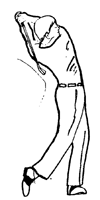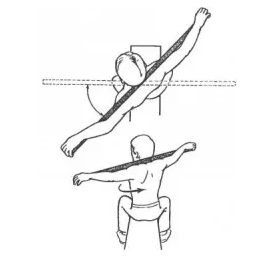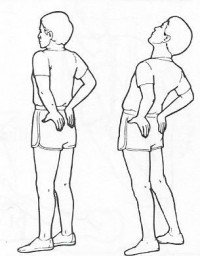
Golf season is coming! Believe it or not golf is a physically demanding sport, and therefore golf injuries are very common. As an example, Tiger Woods had back surgery for an injured lower back disc. As physiotherapists, patients often say to us, “please help me, I absolutely have to get back on the golf course, preferably tomorrow”. No doubt Tiger will also have physiotherapy. The purpose of this article is to learn some common causes of golf injuries, and learn some injury prevention tips and warm-up exercises.
The most common areas of golf injury are the low back, elbow, and wrist. A common factor in golf injuries is a poor set-up, or poor posture before the swing. During a proper set-up, a line can be drawn through the shoulders, knees, and centre of the feet. Please refer to the diagram below. The spine should be essentially straight, with the rear end “stuck out” a little, and the stomach drawn in a little. The head should be kept in a neutral position, not looking directly towards the ground. This is the power position.The correct posture will create a “bouncy feeling”. You will feel relaxed and balanced and not slumped forward.
The swing is also a common cause of injury, particularly to the low back. In the low back, the discs and spinal joints are the structures that are usually injured. The low back is not well suited for twisting motions which puts it more at risk. There are two general types of swings: the classic and the modern swing.
 |  |
| Classic Swing | Modern Swing |
In the classic swing, there is a large hip and shoulder turn, and the golfer finishes in the “I” position, with the trunk straight up and down, directly over the hips. In the modern swing, there is an increased shoulder turn in order to increase the force of swing through the back and shoulders. The hip turn is restricted. The golfer finishes in a reverse “C”, or in hyper-extension of the low back with more twisting of the spine. Please refer to the diagrams above.
The modern swing has been shown to cause more low back trouble, due to the increased amount of twisting and hyper-extending of the low back. Ideally, in the follow-through, your spine should finish in as vertical or straight position as possible, and the right shoulder should end up over the left foot. Limiting the hyper-extension and extra twist will reduce strain in the back.
The most common causes of elbow and wrist trouble in golfers are due to two factors. Firstly, the left elbow, if held too straight and rigid, will create increased amounts of muscle tension throughout the arm, and overuse the muscles and tendons around the elbow and wrist. Secondly, many people grip the clubs too firmly, and again, this overuses the muscles of the arm and wrist. Overusing the muscles and tendons causes micro-trauma, inflammation, and pain. This leads to “golfer’s” elbow which is essentially tendonitis on the inside of the elbow or “tennis” elbow which affects the outside of the elbow. The golf club should be held like a fishing rod when casting. It is held only firm enough just to control the various motions.
We recommend the following warm-up exercises before you tee off to help prevent injuries.
Exercise 1
Starting with your smallest irons, take three swings with each iron, working yourself up to the drivers. The first swing should just be a mini swing – 50% of your swing, then three-quarters, and then a full swing. Perform this sequence of three swings for each club.
Exercise 2
Please refer to the diagram below. This can be done standing or seated. Rotate the trunk in one direction and hold for 10 seconds. Repeat 10 times and come back to the centre position each time. Then repeat 10 times on the other side. It is important to go slowly, and turn until you feel a stretching sensation in your back, but not pain. Your hips should move as you twist.

Exercise 3
Extension in standing: Place your hands on your lower back, and gently bend backwards onto your hands, feeling a stretch in the lower back. Hold for a few seconds and repeat ten times.

Remember golf is a sport with physical demands. Warm ups and good technique will keep you on the course for the whole season. Please do not hesitate to contact Corydon Physiotherapy for questions or a consultation, and “Happy Golfing”!
By Kelly Milan, BMR, PT ©




